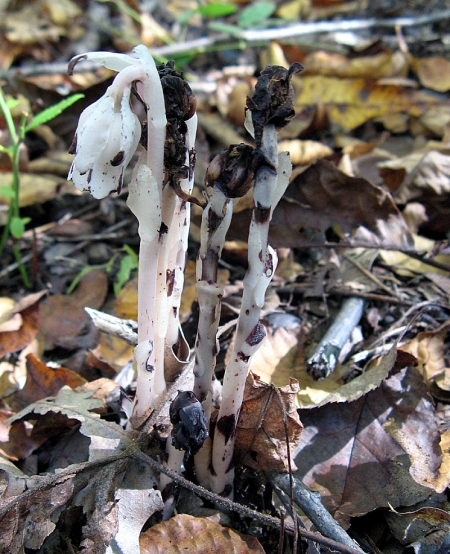A couple of days ago, while scouting for deer sign, I came across this small clump of Indian Pipe (Monotropa uniflora):
I’d only seen an Indian Pipe once before, mainly because by the time it makes it’s appearance I’ve usually moved on to other interests, like preparing for deer season. I didn’t have a camera with me on that previous occasion, so this was my first opportunity for a photograph.
As I was preparing this post, I came to the realization that I knew virtually nothing about this particular plant. A bit of research later and I can tell you that:
- It’s a member of the heath family (Ericaceae), which includes blueberries, azaleas, rhododendron and mountain laurel.
- Even though it’s white, has no chlorophyll and thus does not perform photosynthesis, it is a flowering plant and there are about 3000 species of non-photosynthetic (heterotrophic) flowering plants – many of the others are also of the Ericaceae family.
- Usually found in rich, moist forests with plenty of leaf litter, frequently in areas too shady for plants that do perform photosynthesis.
- Everything has to have a source of sustenance and this plant is parasitic on the beneficial and nearly omni-present mycorrhizal fungi present in the forest floor. Indian pipe is only able to feed from one particular fungi group, the Russula, which can attach to a wide variety of trees, oaks among them.
- Indian pipe seedlings trick the fungi by chemically mimicing the roots of the host tree.
- Ranges throughout the eastern deciduous forest of the United States and Canada as well as the mountains of Central America and northern South America, Japan, China, the Himalayas and India.
- This distribution is wider than almost any modern plant, meaning that it’s likely been around since the Jurassic .
- One to several stems, each up to 10 inches tall (though typically 4-8″) and with a single nodding flower, rise from an underground crown with the flower fully formed.
- The stem, leaves and flower are waxy and very fragile. The single flower has five petals, is up to an inch long and rotates upward once pollinated. The seed capsule matures in this upright position. Following seed maturation, the plant turns black but can remain standing for weeks.
- Each seed contains exactly ten cells with no stored food. Dispersed by the wind, the seeds settle to the ground and just wait for a fungus to feed it.
- Traditional medicine uses the root internally as a sedative and to treat nervous conditions; externally for irritated or infected eyes, warts and bunions. It’s safety, however, has not been proven and it’s considered possibly toxic. That said, some hardy folks find it edible after cooking, claiming it to taste like asparagus.
Now THAT is an interesting plant!
